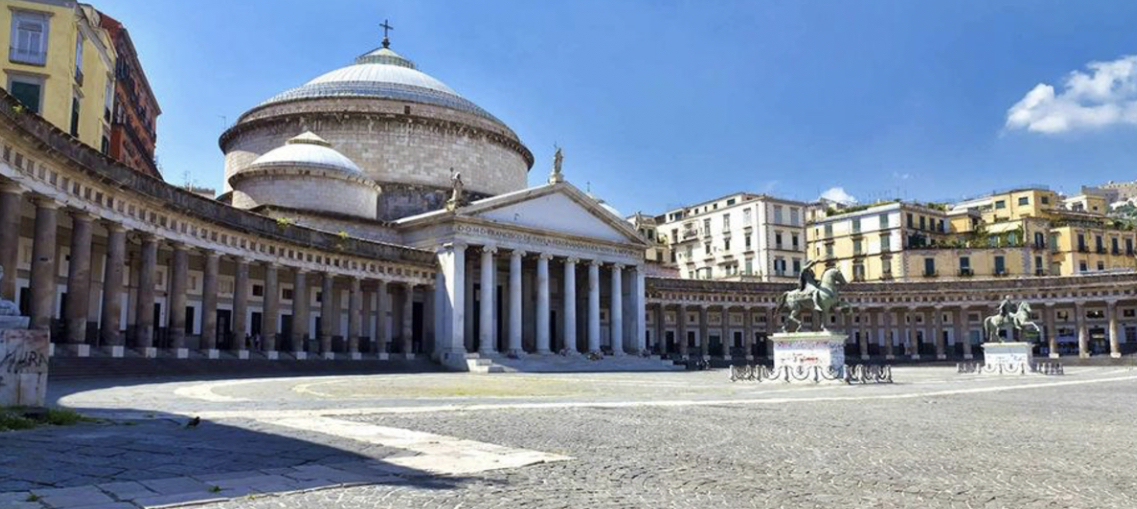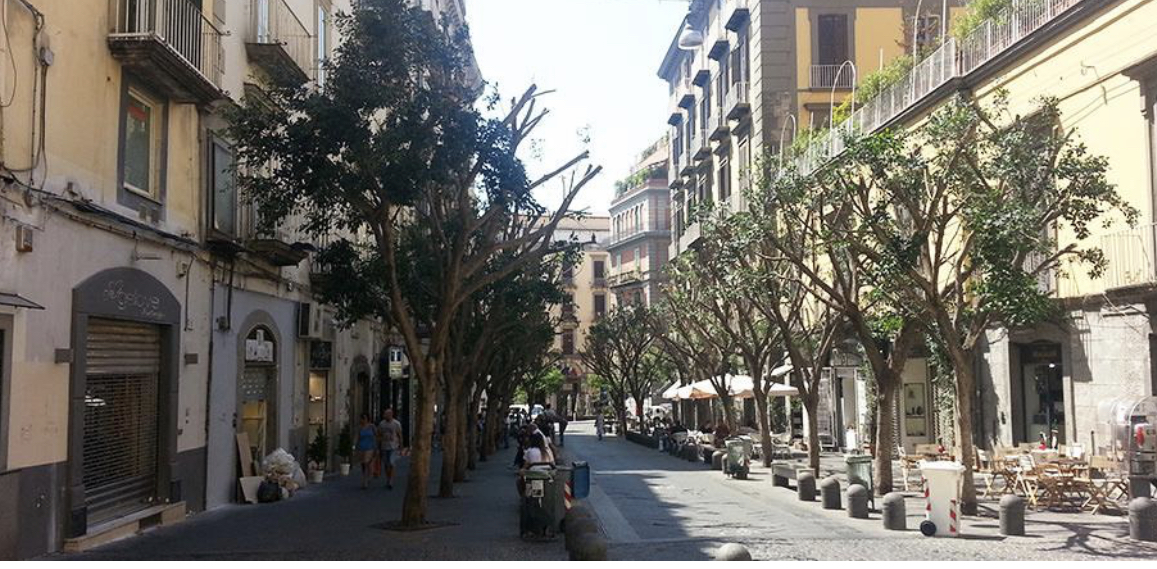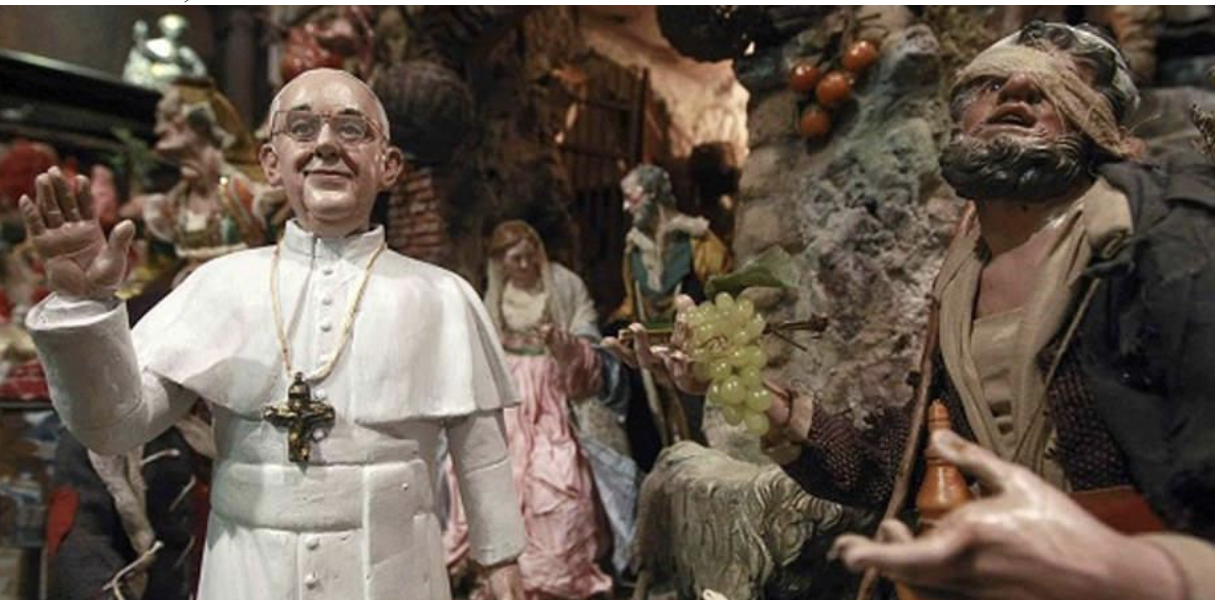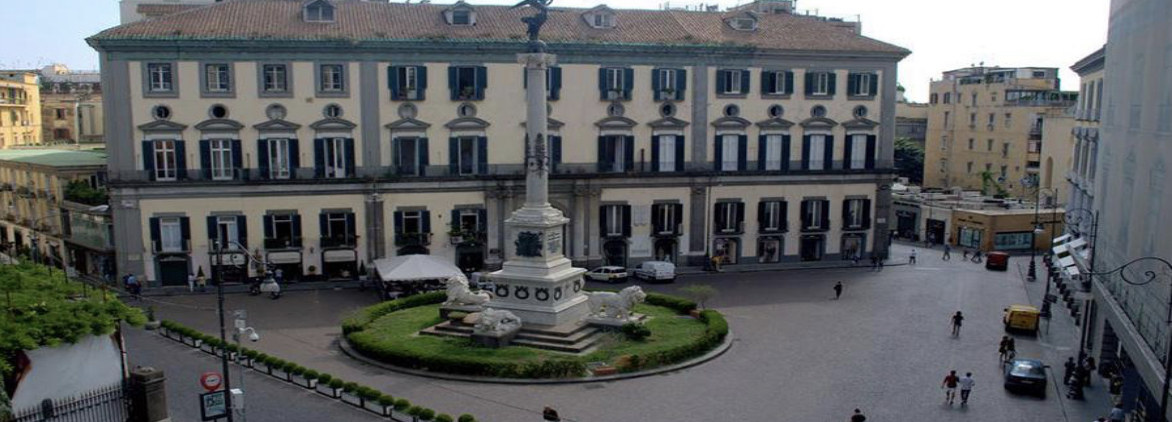Frequently Asked Questions
Angevin Naples
From Palazzo Carafa di Maddaloni, turning right through a stroll in the heart of Naples, with the churches of Santa Chiara and San Lorenzo, or in the area of the Naples port, with a visit to Castel Nuovo and the Church dell'Incoronata, the splendor of the Angevin court is evoked, retracing the history of the Kingdom of Naples.
Aragonese Naples
Exiting Maison des Fleurs, the Aragonese court and Renaissance culture take center stage in this stroll winding through the alleys and most important squares of the historic center of Naples: the churches of San Domenico Maggiore and Sant'Angelo a Nilo, the Pontano Chapel, and the 15th-century Neapolitan palaces serve as the backdrop to this fascinating Neapolitan history.
Between the 1700s and the 1800s
Strolling along Via Toledo, the grand era of Naples as the capital of an autonomous kingdom comes to life through the testimonies of the past: from Piazza del Plebiscito to the Royal Palace, from Teatro San Carlo to Galleria Umberto I, we trace the milestones of the history of the Bourbon family and the events that characterized the history of Naples between the 1700s and 1800s.
From Piazza Dante to Piazza del Plebiscito
 Piazza Dante is one of the most important squares in Naples, located in the historic center, and is characterized by the eponymous statue of the poet built in 1871. On one side stands the National Boarding School with 26 statues representing the virtues of Carlo di Borbone on top, and adjacent to it is Port'Alba, one of the ancient entrances to the city. Piazza Dante is at the beginning of Via Toledo, one of the completely pedestrian shopping streets. On this street, there are stores of major chains as well as local artisans, and it's worth stopping to visit the Toledo Art Station, considered one of the most beautiful in the world. Reaching the other end, after a mandatory stop at Esterina Sorbillo for fried pizza, you arrive at Piazza Trieste e Trento with the famous Caffè Gambrinus and, a short distance away, the San Carlo Theater. Immediately after is the enormous Piazza del Plebiscito, overlooking the Royal Palace and the Basilica of San Francesco di Paola.
Piazza Dante is one of the most important squares in Naples, located in the historic center, and is characterized by the eponymous statue of the poet built in 1871. On one side stands the National Boarding School with 26 statues representing the virtues of Carlo di Borbone on top, and adjacent to it is Port'Alba, one of the ancient entrances to the city. Piazza Dante is at the beginning of Via Toledo, one of the completely pedestrian shopping streets. On this street, there are stores of major chains as well as local artisans, and it's worth stopping to visit the Toledo Art Station, considered one of the most beautiful in the world. Reaching the other end, after a mandatory stop at Esterina Sorbillo for fried pizza, you arrive at Piazza Trieste e Trento with the famous Caffè Gambrinus and, a short distance away, the San Carlo Theater. Immediately after is the enormous Piazza del Plebiscito, overlooking the Royal Palace and the Basilica of San Francesco di Paola.
From Via dei Mille to Via Chiaia
 Via dei Mille, Via Filangieri, and Via Chiaia are among the most frequented streets for those who wish to shop in high-fashion stores. The most famous ones are the large boutique of Louis Vuitton and the jewelry store of Bulgari, must-visit stops for high-quality purchases. Along Via dei Mille, you can also stop at PAN, the Palace of Arts in Naples, which hosts various exhibitions of contemporary and non-contemporary art by local and international artists, almost always with free admission.
Via dei Mille, Via Filangieri, and Via Chiaia are among the most frequented streets for those who wish to shop in high-fashion stores. The most famous ones are the large boutique of Louis Vuitton and the jewelry store of Bulgari, must-visit stops for high-quality purchases. Along Via dei Mille, you can also stop at PAN, the Palace of Arts in Naples, which hosts various exhibitions of contemporary and non-contemporary art by local and international artists, almost always with free admission.
Traveling along Via Filangieri, where you can stop at Prada, you reach Via Chiaia, a street teeming with clothing and shoe stores, but also with street food venues, bars, and ice cream parlors. Along the way, you'll find the Chiaia Bridge, built in 1636, which connects the area to the Pizzofalcone hill (but currently the elevator is out of order), while in a side street, there is the famous Pizzeria Brandi, where it is said that the Margherita pizza was born. At the end of the street, you emerge into the famous Piazza del Plebiscito.
From via San Gregorio Armeno to Via Duomo
 San Gregorio Armeno connects the Lower Decumanus with Via dei Tribunali and is known worldwide as the "Street of the Nativity Scenes." Dozens of artisan workshops display their creations throughout the year, featuring nativity scenes rooted in both tradition and contemporary themes. Along the street, you can stop at the Basilica of San Lorenzo Maggiore, from which you can access the ancient Roman market in the underground, while at the opening onto Via dei Tribunali, there is the monumental Basilica of San Paolo Maggiore, built on the remains of the Temple of the Dioscuri. Just to the side, there is the entrance to Naples Underground.
San Gregorio Armeno connects the Lower Decumanus with Via dei Tribunali and is known worldwide as the "Street of the Nativity Scenes." Dozens of artisan workshops display their creations throughout the year, featuring nativity scenes rooted in both tradition and contemporary themes. Along the street, you can stop at the Basilica of San Lorenzo Maggiore, from which you can access the ancient Roman market in the underground, while at the opening onto Via dei Tribunali, there is the monumental Basilica of San Paolo Maggiore, built on the remains of the Temple of the Dioscuri. Just to the side, there is the entrance to Naples Underground.
Via dei Tribunali is famous for hosting the city's best pizzerias, including renowned names like Sorbillo and Di Matteo. The street is also home to the Pio Monte della Misericordia with Caravaggio's "Seven Works of Mercy." At a certain point, the street intersects with Via Duomo, also known as the "Museum Street." In addition to the Cathedral, there are the Museum of the Treasure of San Gennaro, the Filangieri Museum, the Girolamini Complex, the Diocesan Museum, and the Madre Museum.
Greek-Roman Naples
Our stroll begins at Maison des Fleurs, and we get to know the ancient origins of the city of Naples through a fascinating walk in its historic center: from the Greek walls of Piazza Bellini to Piazza San Gaetano, visiting the archaeological excavations of Neapolis Sotterrata in the church of San Lorenzo, and concluding the journey in the Cathedral with a visit to the ancient Basilica of Santa Restituta. If you wish to explore the settlements by the sea, the Municipio Metro station will transport you to a true Roman port with foundations of bastions and merchant ships. The archaeological park of Pausilypon and the Grotta di Seiano also represent evidence of Naples at its origins.
In the bowels of Naples
Naples Underground (macellum and Greek and Roman walls), Napoli Sotterranea (approximately 40 meters deep), and the Bourbon Tunnel will reveal a Naples that extends beneath the surface, featuring naturalistic and historical sites, as well as guarding the mysteries of the city.
Luxury shopping
 San Pasquale a Chiaia area, surrounded by numerous alleys and small streets, is the snobbish part of the city. After visiting the church of the same name in the square, you can continue along Via Carlo Poerio, stopping in the many antique shops that display paintings, furniture, and even rare objects. Continuing, you reach Piazza dei Martiri, with the monument dedicated to the fallen of the Republic of 1799, where the Feltrinelli megastore is located. Instead, by venturing into the various alleys, you can stroll through Vico Belledonne, Via Cavallerizza, Via Bisignano, and Vico Alabardieri, rich in clothing and gift shops, wineries, and some bakeries, streets that make up the famous bar area. Via dei Mille, Via Filangieri, and Via Chiaia are among the most frequented streets for those who want to shop in high-fashion stores. The most famous ones are the large boutique of Louis Vuitton and the jewelry store of Bulgari, must-visit stops for purchases of international designer products. Along Via dei Mille, you can also stop at PAN, the Palace of Arts in Naples, which hosts various exhibitions of contemporary and non-contemporary art by local and international artists, almost always with free admission. Traveling along Via Filangieri, where you can stop at Prada, you reach Via Chiaia, a street teeming with clothing and shoe stores, but also with street food venues, bars, and ice cream parlors. Along the way, you'll find the Chiaia Bridge, built in 1636, which connects the area to the Pizzofalcone hill (but currently the elevator is out of order). At the end of the street, you emerge into the famous Piazza del Plebiscito.
San Pasquale a Chiaia area, surrounded by numerous alleys and small streets, is the snobbish part of the city. After visiting the church of the same name in the square, you can continue along Via Carlo Poerio, stopping in the many antique shops that display paintings, furniture, and even rare objects. Continuing, you reach Piazza dei Martiri, with the monument dedicated to the fallen of the Republic of 1799, where the Feltrinelli megastore is located. Instead, by venturing into the various alleys, you can stroll through Vico Belledonne, Via Cavallerizza, Via Bisignano, and Vico Alabardieri, rich in clothing and gift shops, wineries, and some bakeries, streets that make up the famous bar area. Via dei Mille, Via Filangieri, and Via Chiaia are among the most frequented streets for those who want to shop in high-fashion stores. The most famous ones are the large boutique of Louis Vuitton and the jewelry store of Bulgari, must-visit stops for purchases of international designer products. Along Via dei Mille, you can also stop at PAN, the Palace of Arts in Naples, which hosts various exhibitions of contemporary and non-contemporary art by local and international artists, almost always with free admission. Traveling along Via Filangieri, where you can stop at Prada, you reach Via Chiaia, a street teeming with clothing and shoe stores, but also with street food venues, bars, and ice cream parlors. Along the way, you'll find the Chiaia Bridge, built in 1636, which connects the area to the Pizzofalcone hill (but currently the elevator is out of order). At the end of the street, you emerge into the famous Piazza del Plebiscito.
Pietrarsa Museum
With its late 19th-century locomotives and the magnificent Royal Palace of Portici, they remain magical places to visit, a regional train departing from the nearby metro station that takes you directly to your destination.

